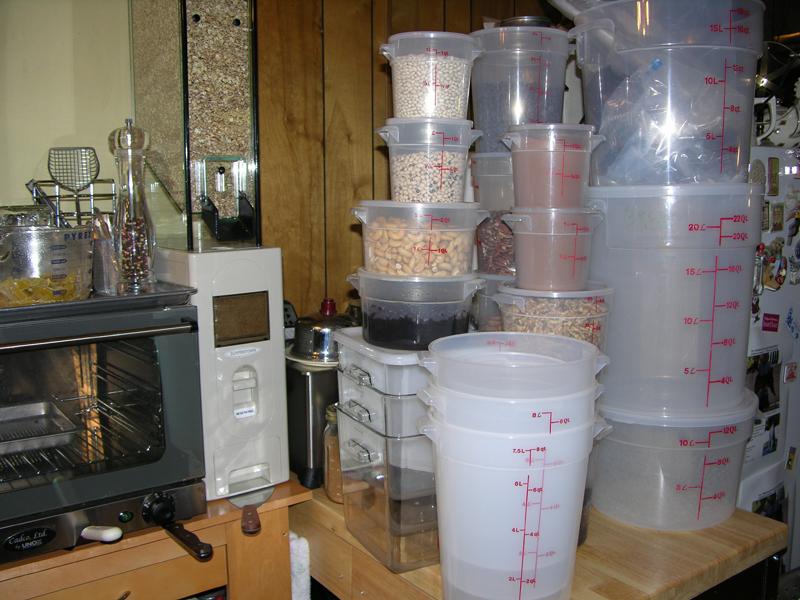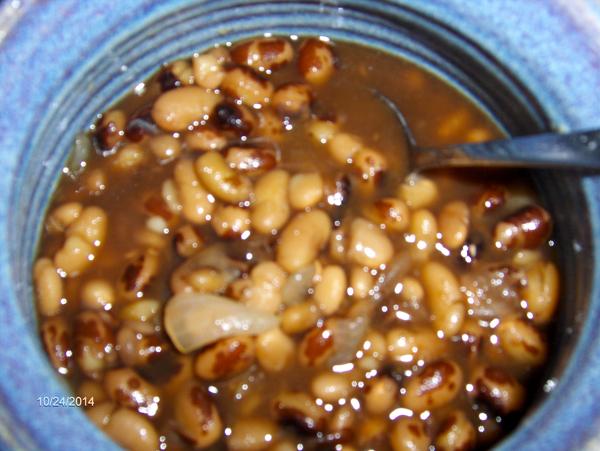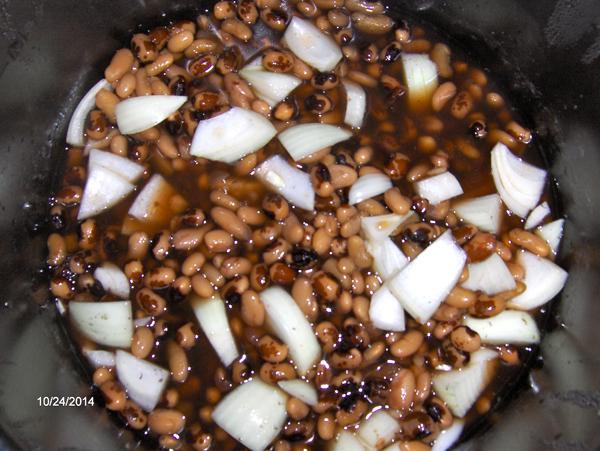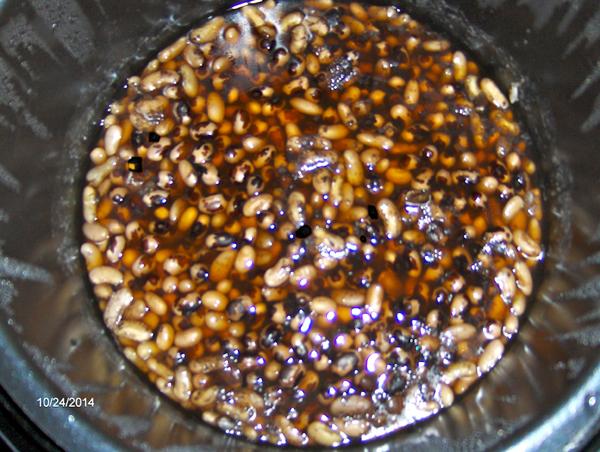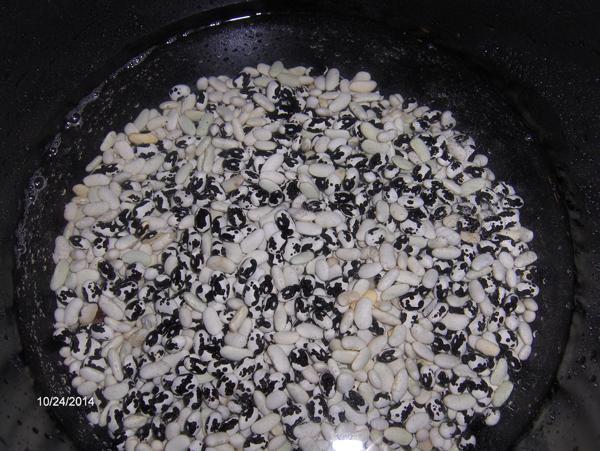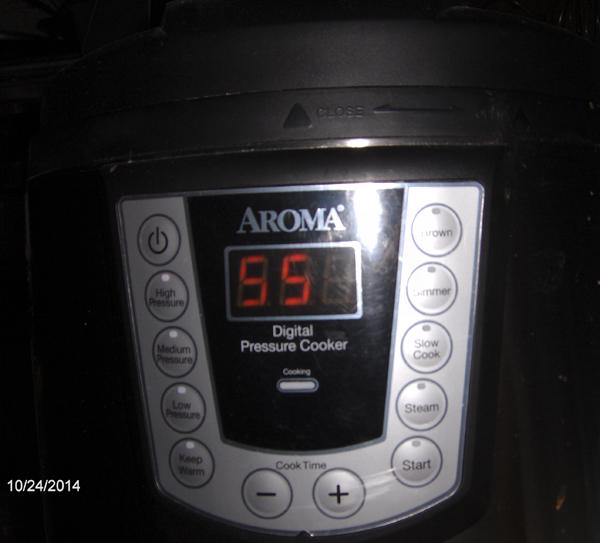-
Posts
11,033 -
Joined
-
Last visited
Content Type
Profiles
Forums
Store
Help Articles
Everything posted by andiesenji
-
regular beef FAT (as opposed to real suet or kidney suet) renders more easily when ground coarsely. I grind it with a meat grinder and pack it into 2 - 3 pound portions and keep in the freezer. I render it in the oven, in a deep roasting pan or French or Dutch oven starting with enough water to cover the bottom of the roaster by 1/2 to 1 inch and the roaster goes into the cold oven and I set the temp for 250°F. and the timer for two hours to start with. At the end of that time I stir and turn the fat solids and add more water if necessary and put it back for another two hours. At this point I draw off most of the liquid into a deep bowl and leave it to cool - add some more water to the roasting pan and put it back in the oven for another hour or so - to get the last of the fat. After the first batch of fat has cooled, the bowl goes into the fridge so the fat will solidify and it can then be easily separated from any water in the bottom of the bowl. Kidney suet should also be rendered in water and can be rendered on the stove top over very low heat, but I prefer the oven method and at a lower temp, 200 to 225 at most. I just break it into chunks and chop till it looks about pea-sized. You can also use a Crockpot or slow cooker. There are distinct advantage to this because you don't really have to watch it. There are a couple of blogs that discuss this in detail. I will try to find the most recent entry that has some excellent advice.
-
My all-time favorite one-dish meal is meatless, pasta e fagioli and I vary it with different types of beans and different types or shapes of pasta. If desired one can add meats - smoked ham, bacon, leftover cooked beef, pork or chicken. Endless choices.
-
I have Cambro containers from 1 quart to 22 quart and when I was baking big batches of bread, I would have dough working in two of the 22 qt containers. I use them for storage, for brining, for pickling and etc. In my opinion they are very reasonably priced - I bought most of mine at Smart & Final.
-
I have all kinds of bowls but I usually use a Cambro container with a lid. I prefer to have a container that is MUCH LARGER than 8 cup because I have often had bread doughs rise much more than expected - some can triple in volume and go exploring outside the container if the space is not adequate. Some doughs that are heavier are more predictable but some, such as sourdoughs are not.
-
More and more, I am experimenting with combining two (or more) types of beans. This combo was inspired. I am aiming to combine some varieties that break down easily (soup type) with those that hold their shape so I can have a thick beany broth that contains whole beans that have a creamy interior but a secure skin.
-

Making pastry, can all-purpose flour substitute for cake flour?
andiesenji replied to a topic in Pastry & Baking
That's true. I thought you were referring to the soft wheat flour in your earlier post. Sorry I misunderstood. There are indeed regional variations in flour types. Fortunately, now we can order online and buy flour from other locales to suit our baking preferences. After growing up in Kentucky and then going to live with my mom in Wisconsin, it was quite a shock when my biscuits did not turn out as expected. I was mortified until I learned that I could "borrow" some of the pastry flour from mom's bakery and use that successfully. -
A couple of days ago I again cooked a combination of two types of beans - in the pressure cooker (automatic electric). This "medley" was Vaquero and Flagolet - about 2/3 cup of each. As these have been around for a while, the cooking time is much longer than normal After cooking have added large chunks of onion and reset timer for 10 minutes Served... Delicious and 100% vegetarian - some guava-smoked salt added to give a hint of smokiness... These had an exceptional "meaty" flavor.
-

Making pastry, can all-purpose flour substitute for cake flour?
andiesenji replied to a topic in Pastry & Baking
Wondra is not available everywhere. Not in Australia for sure - I'm active on ForumThermomix that has mostly Aussie members and while corn flour is easily found, there is no Wondra down under... -

Making pastry, can all-purpose flour substitute for cake flour?
andiesenji replied to a topic in Pastry & Baking
I think you mean the "soft" wheat flours (White Lily) that is used for biscuits, pastry, quick breads and is most easily found in the the SE U.S. As opposed to hard winter wheat which has higher gluten and protein and is better for yeast breads, etc. All-purpose flour is a "compromise" between soft wheat and hard wheat and can be used for anything but is not truly optimall for artisan breads or for fine pastries but it will do. To "make" cake flour using all-purpose, simply measure out your flour - for EACH cup of flour remove 2 Tablespoons and in its place ADD 2 Tablespoons of cornstarch (corn flour in the UK, Australia, etc.) mix and SIFT FOUR TIMES. This thoroughly blends and aerates the flour. Now you have cake flour... -
For "regular" saute items, I just watch to see the oil "ripple" which indicates to me that it is time to add the food. I've been doing this for more than 60 years and it works ok for me. For wok stir-fry I took a tip many years ago from a friend who owned a restaurant up the street from me when I lived in Reseda, CA. He showed me that they add oil that is already hot to the woks and so it is instantly ready. I put the oil I'm going to use in a small tea kettle and keep it over a low flame so it is hot but not smoking and then pour a bit into the heated wok. Instantly ready to add the meats and then the vegetables.
-
My "secret" to cooking really huge birds, which I did in the past, was to braise them on the stove top (in the largest Magnalite roaster) until the "done" temp was reached then uncover and into the oven for 35 minutes to brown the surface. Moist all the way through and vast amounts of dripping for gravy. I still have one of those big roasters and it is going on ebay soon. I have to have my aortic valve fixed soon and til then am forbidden to lift more than 10 pounds... Drat.
-
2013 prices of free range, organic turkeys in the bay area range from reasonable to high. Notes HERE. I can get turkeys, geese, ducks, even pheasant from my "egg man" (who does not want his name bandied about to "strangers") at extremely reasonable prices (often free) because I have done him some favors and given him some of the butchering tools I used to use (meat bandsaw) mainly to clear up some space... I bought one of the "high end - heirloom" turkeys a few years ago and was NOT impressed with the flavor - or the texture of the meat. The "slow-grow" turkeys from Diestel are available at a local health food store - Whole Foods is an hour drive for me - one way. And they are pretty good. I got one last year at the 3.89 per pound price. This year my ex-neighbors are raising several turkeys for the holidays and as they have invited me for Thanksgiving, I doubt I will buy one for just me. I have reserved a pheasant from the egg man for when he gets around to butchering for family and friends - as he now has a huge number of game birds he is really busy and now has a local licensed abbatoir dressing the birds for commercial sale.
-
A comprehensive list of the smoke points on various oils can be found here. Note that some grapeseed oils have a higher smoke point than others. I believe I mentioned earlier in this thread that I have been using REFINED safflower oil for frying. I like it because it does not have an unpleasant odor when it gets really hot when a scant amount is used over high heat (in a wok). I like the flaxseed oil for low temp saute and also for use IN baked goods. I routinely use it in my breads with great results.
-
Such a wonderful window into a time with good cooking, descriptions and photos of the local area and foods. Thanks so much for allowing us into your island adventures.
-

Making homemade yogurt with clay pots--has anyone done this?
andiesenji replied to a topic in Cooking
The Chamba pots are porous. If you fill one with water and allow it to set on an absorbent mat for several hours or overnight, you will find the mat is damp. This was an advantage for people who wanted cool water because the evaporation cooled the liquid inside. I have a couple of Chamba pots (and a comal) but I would not trust them with my yogurt because it is always possible to pick up a pathogen and once it is in the clay, it is very difficult to eradicate. I didn't observe this with yogurt but with one of my sourdough cultures that was just fine in a glass jar but when I divided it and put some into one of the Chamba pots it developed the "pink slime of death..." disaster for sourdoughs. -
I had some Moro and some Rebosero beans from RG - about a cup of each and mixed them together (they are related) and cooked them in the pressure cooker (they were not "fresh" by any means) for longer than "normal" and they turned out very good. Quite a "meaty" flavor, intact tender skins but creamy interior. The next batch will be some Appaloosa beans that have been in the container for a year and need to be cooked very soon.
-
I use 1/2 cup vinegar to a gallon of water - I use this to clean apples, pears, nectarines, plums, grapes and tomatoes, etc., from the market - it will remove some of the wax, not all but it also seems to inhibit the hatch of fruit flies...
-
I usually just pull off the husks and drop them into a bowl of warm water with vinegar, swish them around a bit and dump into a colander to drain. Then they go into a roasting pan because I can't eat them raw. I cut the very large ones into halve, quarters or smaller - just so all the pieces are about the same size. I have substituted them in green tomato chutney when the green tomato supply was nil and also made the green tomato pie filling (on my blog) with tomatillos successfully. I didn't grow any this year because I just couldn't handle the effort required. I have used them from marble size to baseball size and some are dark green, some light green and there is even a purple variety (the Mexican supermarket has the latter occasionally but one has to get in early because they sell out rapidly).
-
Same for the dairy cows in Wisconsin. They stay on the hillsides because much of the lower, flat areas between the hills is boggy.
-
That "terraced" hill looks like a lot of hills in the "kettle morraine" region of Wisconsin where the hills (mostly gravel under a thick surface of soil) were shaped by the retreating glaciers as they melted. Some of the hills on my folks farm (actually a "hobby" farm) looked like steps had been carved on purpose around the circumference of the hill but it was all natural and some of the trees on the hills had been there from long before white settlers moved in.
-
The stainless steel maslin pans will work perfectly well for jams and jellies and are much easier to maintain and can also be used with high acid foods. Also much less expensive. I do believe for sugar work unlined copper is best to control the way the sugar/caramel behaves but for your purpose, get the stainless - it is the shape of the maslin pan which is important. For very small batches of jams and jellies I use a "Windsor" pan which has essentially the same shape as the maslin on a small scale. I have two, one is Calphalon (aluminum) and the other is All-Clad stainless.
-
Doesn't anyone make divinity any more? That used to be the favority candy of my family during the holidays where I was a child and I made it for years, until I developed diabetes and had to cut back on the sweet stuff. Some was colored green (a pale, "sea-foam" green)and contained pecans. some was pink and contained crushed peppermint and some a deep yellow "gold" color that had nonpareils mixed in and of course the white which contained shredded coconut. I recall that it started with a dozen egg whites, beaten by hand by my grandma's cook, who had arms like a wrestler. There is a very similar but much smaller recipe here . Note the advice about the wooden spoon... One does not use a metal spoon because heat travels up that handle rapidly! Unless you have a metal spoon with a wood handle - or something that insulates it. They didn't use cookie scoops, they used two soup spoons, constantly dipped in warm water to form and drop the bonbons.
-
I have problems sitting at the computer - edema in my feet and legs - so I have to be in a recliner and also sleep there because can't lie flat. Right now am limited to no more than 30 minutes sitting at my desk and then must be 2 hours with feet elevated. Am reading a lot but the inactivity really gets old after a while. I am using my automatic appliances more. Electric pressure cooker - the rice cooker, the slow cooker and the bread machine - pre-programmed where applicable.
-
Seeing your photos reminds me of how much I miss preparing the big batches of candied ginger I made in the past. It was always a chore but I enjoyed it so much. I still have a couple of pounds from the last batch I made a year ago - probably a bit dry but I can always steam it to give it a refresh, followed by a new coating of granulated sugar.
-
Three years ago when this thread first appeared I wrote extensively about my experiences with brewing tea from three different hot water sources. There was no discernible taste in the tea from the Zojirushi water boiler that had been filled at least 3 hours earlier and was set to boil the water and then hold it at 205°F., the water from my InstaHot at the sink and freshly drawn water boiled in a kettle on the stove. Water can absorb oxygen just by being poured - "agitation" - and with bubbles forming and breaking while it is boiling. I have British friends who grew up drinking tea brewed with water that had been heated in large urns and held at near boiling for hours. They laugh at the notion that reboiling water causes it to taste bad. UNLESS THE WATER IS AWFUL TO START WITH. There are excellent filter systems now available that remove chlorine and other chemicals from tap water and if that is used there is no reason to waste water that has been boiled.



